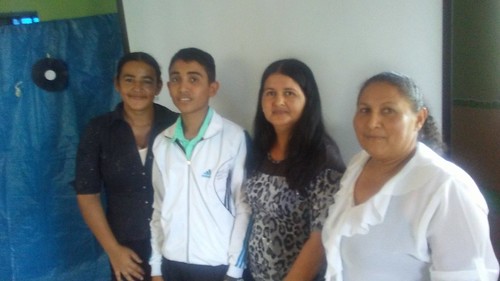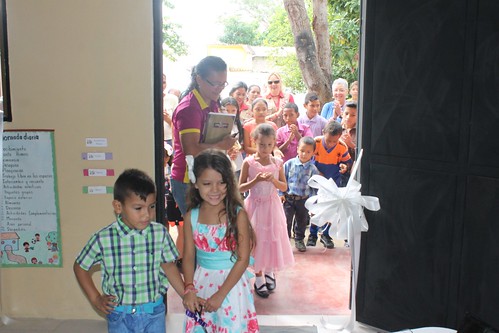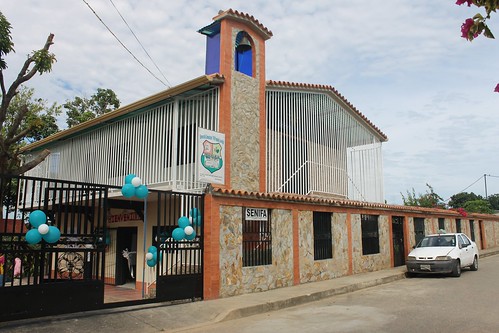July 2022 was a time of transitions for us. We closed our first
school of in-person classes since 2020 and saw two former preschool
students graduate from high school. Luz Maria and I took our first
road trip together since 2019 for the graduation of 35 women who Luz
Maria mentored for three years as deaconesses.
We were able to
reopen the preschool in October 2021 under a number of restrictions.
Our 25 students were split into four groups of five, each one
attending two days a week. Strict sanitary procedures were required,
including wearing of masks. Getting two- to three-year-old children
to wear masks at all times was as easy as you might expect. This
situation lasted through the fall, but after the Christmas/New Year
break, all of the children were able to gather in one group each day.
On July 6, we celebrated the end of the 2021/2022 school year with
the children and their parents.

Our high school
graduates were Yaneth Torres and Daiyamar Aranguran. Daiyamar
attended our preschool until 2010, when she graduated to Virginia de
Contreras Elementary School. Yaneth not only attended our preschool,
but was one of the first children baptized at our mission, was later
confirmed and remains a communicant member. She graduated third in
her class. Yaneth’s younger sister, Diana, also attended our
preschool, was baptized at our mission, and on October 31, 2021,
became a communicant member.
The Torres sisters
both received scholarships to continue their education from
LeadaChild,
an Olathe, Kansas-based mission society which promotes Christian
education around the world. LeadaChild has supported children in our
mission since 2006.
Also, Anyi Garrido,
Luz Maria’s granddaughter, graduated from Virginia de Contreras and
will begin high school this fall.
Deaconess
formation at the end of a long road
Luz Maria and I set
out across the country of Venezuela on July 7, from La Caramuca,
which is closer to the Colombian border than to the capital city of
Caracas, to Maturin in Monagas state, which is a nearly equal
distance to the east of Caracas. We stayed the night in Caracas, then
arrived in Maturin for the beginning of a final seminar for the women
who had been studying to become deaconesses for three years. Together
with Pastor Ángel Eliezer Montoya, director of the Juan de Frías
Theological Institute, Luz Maria had guided these women in their
studies, mostly online during the COVID-19 crisis. This was
despite frequent lapses in electrical power and Internet service.
Their graduation service was on Friday, July 22, at Cristo Rey
Lutheran Church, with preaching by Pastor Sergio
Fritzler of Seminario Concordia El Reformador, the Dominican
Republic.

The diaconate, or
“helping ministry” has its origin in the ancient church. In Acts
6 we find the apostles delegating tasks essential to the life of the
church, but not to the pastoral office, to trusted laypeople. The
seven men mentioned in that chapter are the first to be called
“deacons”, a word which means servant. In Romans 16:1-2, St. Paul
describes Phoebe of Cenchrea as a “deacon”. The word is masculine
in form, but since it refers to a woman, some English translations
render it as “deaconess”. Phoebe is the only woman to explicitly
receive this designation, but we read of other women who held
responsible positions of service in the New Testament church,
including Dorcas (Acts 9:39-41), Lydia (Acts 16:14, 40) and Priscilla
(Acts 18:2,18,26).

In later centuries
of the church, both deacon and deaconess became formal titles. The
earliest reference to deaconesses outside of the New Testament is the
infamous letter by Pliny the Younger, a Roman magistrate of the
second century A.D., to the Emperor Trajan. In his effort to
investigate the new Christian religion, Pliny mentions that he had
two deaconesses tortured to find out what it was really about, but
they would give no answers that satisfied Pliny. After the end of
Roman persecution in the early fourth century, deaconesses would play
an important role in assisting pastors and bishops. Among
the
classics of post-apostolic Christian literature are the 17
letters that John Chrysostom, archbishop of Constantinople from the
late fourth to early fifth centuries, wrote from exile to his chief
deaconess, Olympias. The letters typically begin in this way: “To
the most reverend and divinely favored deaconess Olympias, I John,
Bishop, send greeting in the Lord.”
While deaconesses
were excluded from the pastoral office of public preaching and
administration of the sacraments, their works of mercy and spiritual
were was considered equal with the male diaconate. The diaconate was
at first a lay ministry, but as the church developed more of a
hierarchy, male deacons were elevated from the equivalent of modern
lay elders to the lowest rank of the ordained clergy. The role of
deaconesses was taken over by nuns, and use of the word eventually
stopped.
But as early as the
tenth century there flourished in Germany and Belgium the Beguine Sisterhoods, founded on the principle of fellowship and consisting of
widows and unmarried girls who, without vowing perpetual chastity,
led lives of prayer, meditation, and charitable ministrations. These
sisters cared for orphans and the aged, went out to nurse the sick,
to attend deathbeds.
The modern deaconess
movement began in Kaiserswerth, Germany, in 1836, revived by
Theodore Fliedner, a Lutheran
pastor.
Fliedner
opened a hospital and a deaconess motherhouse. The
Kaiserswerth-based institution of also purchased and staffed
hospitals, homes, orphanages, and schools in other parts of Germany
and around the world.
In 1853, Johann
Konrad Wilhelm Loehe opened a school for deaconesses in
Neuendettelsau, Bavaria, on stricter Lutheran principles. Loehe’s
school had a strong impact on deaconess
programs within the Lutheran Church – Missouri Synod (LCMS).
Laying groundwork
in Venezuela
Before the 2000s,
the Lutheran Church of Venezuela’s Juan de Frias Theological
Institute did not offer a deaconess program distinct from its
training of both male and female lay leaders. Two women who achieved
the highest level of theological training offered by the institute,
Luz Maria and Elsy Valladares de Machado, eventually were given the
title “deaconess” by the national church and named co-coordinators of a national deaconess program.
From 2002 to 2003,
Mireya Johnson, who received her deaconess certificate is from
Concordia University Chicago, and an MA in Religious Studies from
Concordia Theological Seminary, Fort Wayne, Indiana, laid the
groundwork for a deaconess program in Venezuela. Her husband, Dr.
Ross Johnson, now director of LCMS Disaster Response and another Fort
Wayne graduate, served his vicarage at La Fortaleza Lutheran Church
in Maracay, Venezuela, during that time. Thanks to Mireya’s hard
work and example, many young women in Maracay were moved to consider
becoming deaconesses.

Deaconess Rosie
Gilbert Adle in 2007 served her deaconess internship in Venezuela.
She had earned a BA in Spanish from Valparaiso University in Indiana
in 2003, and graduated from Concordia Seminary, St. Louis, in 2006
with an MA in deaconess studies and systematic theology. She worked
with Luz Maria, Elsy and Pastor Ted Krey, now region director for
Latin America and the Caribbean for LCMS World Missions, on a
training program for deaconesses in Venezuela.
In May, 2009, Luz
Maria and Elsy traveled to Seminario
Concordia, Buenos Aires, Argentina, for the first-ever conference
of deaconesses throughout Latin America. In 2016, Luz Maria and I
traveled with Elsy, Pastor Mendoza and his wife, Ginnatriz, to the
second conference of Latin American deaconesses at the newly
established Seminario Concordia El Reformador in the Dominican
Republic. Although Venezuelan by birth, Ginnatriz was trained as a
deaconess at the Buenos Aires seminary.
Seminario
Concordia El Reformador has committed a great deal of resources
to this program. Congratulations also are in order for deaconesses
Danelle Putnam
and Caitlin
Ramírez, who provided online instruction from the Dominican
Republic.
Meaningful
memorabilia
Of the women who
completed the coursework, 31 were able to attend the graduation
ceremony in Maturín and four were recognized despite their absence.
Those present received their certificate and several gifts, including
a copy of “Un Siglo de Consagración”, collection of sermons
preached at the consecration or installation of deaconesses from 1924
to 2017. The book is the excellent work of Deaconess Cheryl Dorothy
Naumann from the Dominican Republic, filled with the sermons of
well-known preachers in the history of the Missouri Synod. However,
the most recent entries have special meaning for Luz María and me.
The 30th sermon was preached on Matthew 25:31-46, October 3, 2015, by
Pastor Bruce Keseman at Christ Our Savior Lutheran Church, Freeburg,
Illinois, on the occasion of the commissioning of Deaconess Dorothy
E.A.C. Glenn Nauman. This congregation is my mother's church and has
faithfully supported our mission in La Caramuca. Pastor Keseman
preached at my father's funeral in 2000 and at the funeral of my
sister, Deborah, on February 26, 2022. The thirty-first sermon was
preached by Pastor Theodore Krey on October 1, 2017 at the
“Concordia” Lutheran Church in Palmar Arriba, the Dominican
Republic, for the consecration of deaconesses Confesora Cabrera,
Xiomara Cruz Pería, Carmen Helena de Santos and Elizabeth Hernández
Toribio. Pastor Krey officiated the wedding of Luz María and I, on
July 25, 2004, at the “La Fortaleza” Lutheran Church, in Maracay,
Edo. Aragua, Venezuela. He was also one of the pastors who laid hands
on me at my ordination, on December 13, 2008, in the “El Salvador”
Lutheran Church, Caracas, Venezuela. Prior to my ordination, Pastor
Krey preached and administered the sacraments at La Epiphany Lutheran
Mission in La Caramuca.

Introduction to
new Spanish hymnal
While Luz Maria and
the other women were summing up what they had learned over the last
three years, Pastor Fritzler was giving me and the other pastors of
the Lutheran Church of Venezuela an introduction to Himnario
Luterano, the new Spanish hymnal which is the fruit of 14 years of
work by churches throughout Latin America with quia subscription to
the Unaltered Augsburg Confession of 1530. This really deserves a
newsletter to itself, but here are some preliminary observations:
Himnario
Luterano looks a lot like the Lutheran Service Book: same
typography, illustrations, organizational structure and numbering
format. Unlike the LSB, it combines many more liturgical and
devotional resources into just one book. It is intended as a
multi-use volume for the home as well as public worship.
Why even a
printed volume? I will not now discuss why I do not think electronic
screens belong in the sanctuary in principle, but only note with the
publishers of the hymnal that only about 20 percent of Lutheran
congregations in Latin America even have access to screens.
Certainly in La Caramuca, our Sunday service cannot depend on a
constant flow of electricity.
The musical
notation is written for guitar and piano. There are many who say the
pipe organ is the best instrument to accompany congregational song,
but pipe organs are expensive here, and it is difficult to find
people who know how to play, maintain and repair them.
One too many
potholes
Our journey to
Maturín was without incident. However, we discovered that the roads
in eastern Venezuela are in worse condition than the west, and we
failed to avoid one to many potholes. A shock absorber blew out while
we were only an hour’s drive west of Caracas. Thanks be to God, we
were able to find a tow truck that would take us into the city and
one of the women riding with us had a son who is a mechanic.
Our mission-mobile
is a Volkswagen Parati Crossover, a station wagon (or “small SUV”,
if you will) that was sold in North America as the VW Fox Wagon. It
is named after Paraty, a city on the southern coast of Rio de Janeiro
state. Volkwagen is the
largest auto manufacturer in Brazil. Autoweek
thinks the Parati is not up to U.S. standards, but it works for us.

















































